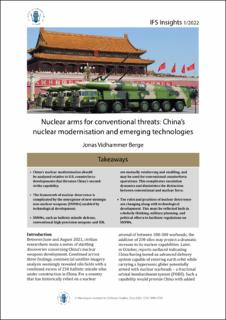| dc.description.abstract | • China’s nuclear modernisation should be analysed relative to U.S. counterforce developments that threaten China’s secondstrike capability.
• The framework of nuclear deterrence is complicated by the emergence of new strategic non-nuclear weapons (SNNWs) enabled by technological development.
• SNNWs, such as ballistic missile defense, conventional high-precision weapons and ISR, are mutually reinforcing and enabling, and may be used for conventional counterforce operations. This complicates escalation dynamics and diminishes the distinction between conventional and nuclear force.
• The rules and practices of nuclear deterrence are changing along with technological development. This must be reflected both in scholarly thinking, military planning, and political efforts to facilitate regulations on SNNWs. | en_US |
